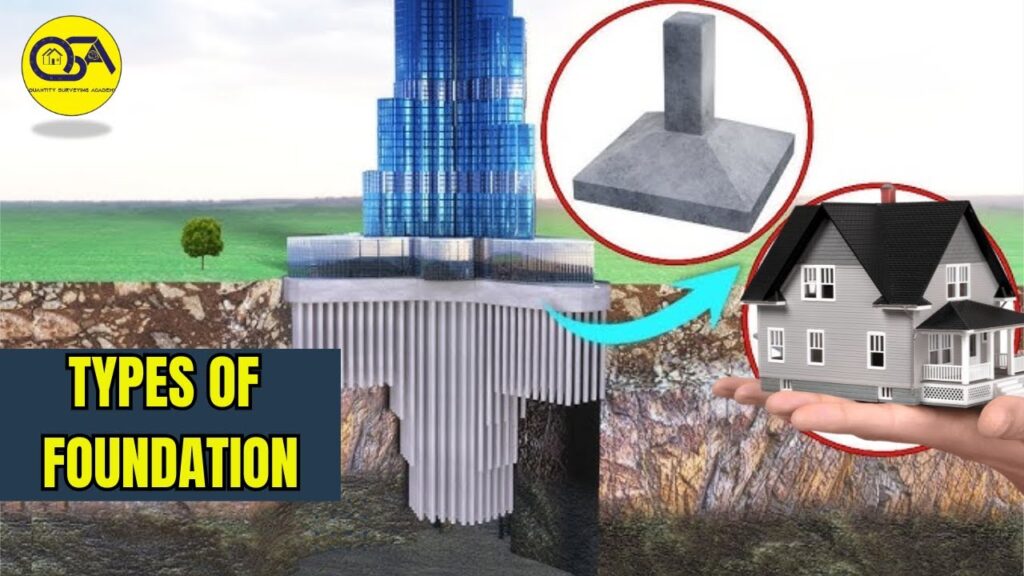What are the types of foundations you would use to construct a two-story building in a desert? Or what would be your choice of foundation when you are tasked with erecting a building on either a river, a solid rock surface, or soft soil subjected to flooding?
In this article, we shall discuss the types of foundations and the conditions on which each of them can be utilized during construction.
What Is A Building Foundation?
As you already know, every building must have a structural footing that is responsible for carrying its load and transferring it to the ground. That is what we call foundation…
The foundation is the lowest load-bearing part of a building, typically below ground level. It is part of the structural system that supports the superstructure of a building and transmits its loads directly to the earth, thereby giving the building the balance and stability it requires throughout its lifespan.
If a building’s foundation is faulty, it might result in a structural failure that could put the lives of its occupants in danger. To put this into perspective, the tower of Pisa in Italy experienced a foundation failure, which made it lean sideways. As a result, it could not be used for the very purpose for which it was constructed.
Selecting a foundation type for construction is dependent on two factors. The first factor is the total load of the structure, and the second factor is The load-bearing capacity of the soil.
Classification Of Foundations:
We have classified foundations into two categories. These are shallow and deep foundations.
1. Shallow Foundations:
Shallow foundations are often used when the load of the structure is relatively low in comparison to the surface soil-bearing capacity. That means you do not have to dig deeper trenches to reach a strata that can hold the weight of the building. This category of foundation is commonly used in the construction of normal residential buildings like bungalows.
2. Deep Foundations:
On the other hand, a Deep foundation is used when the surface soil’s bearing capacity is not strong enough to support the building’s loads. As a result, there is usually a need to dig deeper into the ground and find a hard and durable strata that has a larger bearing capacity.
For example, the foundations used when erecting skyscrapers, multi-story buildings, bridges, and other heavy engineering construction like dams are usually deep foundations.
Types Of Shallow Foundation:
Below are the three types of shallow foundations used in construction.
1. Strip foundations
This comprises of a strip of concrete constructed along the walls of a building. A strip foundation is a type of shallow foundation often used within low to medium-rise residential buildings. It is suitable only where the ground conditions are stable and with good load-bearing capacity.
Well, here in Nigeria, many people have decided to cut costs by constructing their strip foundations with only gravel. They would excavate the trench, pour gravel in it, and commence bricklaying immediately.
Although this practice is dangerous, their buildings have stood solidly for many years. This is because the country isn’t affected by natural disasters that result in the trembling and rumbling of the ground.
Except where strip foundations are constructed on rock, the strip foundations should have a minimum depth of 0.45m to their underside to avoid the action of frost.
This depth, however, will commonly need to be increased in areas subject to long periods of frost or in order to transfer the loading onto satisfactory ground. Strip foundation is also fast and cost-effective to build.
2. Individual footings/Pad Foundation
This is one of the most common foundation types seen in construction and is used when the overall building load is supported by columns. The pad foundation comprises a piece of rectangular or square concrete pad that the column sits on.
It is responsible for transmitting the point load from the columns to the ground. In most low to medium-rise residential buildings, a Pad foundation is used alongside strip foundations. It is often reinforced either at the bottom or at the top and bottom.
The reinforcement bars placed in the pad footing are usually called baskets. There are different variations of pad foundations; They include plain, reinforced, combined, continuous, pad, and ground beam; however, we shall cover them in another video.
3. Mat/Raft foundations
A raft foundation is made up of a thick concrete slab resting on a large area of soil reinforced with steel, supporting columns, or walls, which transfer loads from the structure to the soil. Usually, Mat foundations are most often utilized when the soil has a low bearing capacity and the loads need to be spread evenly over a large area.
As a result, the mat foundation is spread over the entire area of the structure it is supporting. A Raft foundation is most frequently used when constructing basements.
This foundation type utilizes the basement as the foundation and ensures that the weight of the structure is spread consistently throughout the building’s entirety. It is also combined with other foundation types in the construction of high-rise commercial buildings.
Types Of Deep Foundations
The following are the most common types of deep foundations used in construction:
1. Pile foundations
A pile foundation comprises a slender column or long cylinder made of materials such as concrete or steel that is used to support structures and transfer the structural load to deeper strata. The loads are either transferred to the ground through skin friction or at the end bearing.
This type of foundation is most commonly used when the surface soil has a low bearing capacity or when a structure has concentrated loads in particular areas rather than evenly distributed throughout the building. They are used in the construction of bridges, high-rise commercial buildings, embankments, Dams, etc.
2. Drilled shafts
Drilled shafts, sometimes referred to as caissons, are deep foundations that work similarly to pile foundations. However, they offer a higher level of load capacity. Construction professionals use an auger to drill the shafts up to 100 feet into the ground.
These shafts can then help transfer loads of columns evenly throughout the structure. There are several types of shafts or caissons, with the most commonly used ones being sump caissons, pneumatic caissons, open caissons, box caissons, and monolithic caissons.
3. Bouyant Foundations
The Buoyant foundation is designed to support heavy loads on soft soil surfaces. This foundation acts as a floating substructure and tends to reduce the load intensity over the soil. It is mostly referred to as floating raft foundations, hollow box foundations, or compensated foundations.
This type of foundation is constructed in areas that are subjected to flooding. The construction is done by first attaching a steel frame that holds the flotation blocks to the underside of the house. Afterward, four vertical guidance posts are installed not far from the corners of the house.
When flooding occurs, the flotation blocks lift the house and ensure that the house stays afloat on the flooded water. At the same time, the four vertical guidance posts will resist any lateral forces from wind and flowing water, thereby ensuring that the house is not washed away by the water current.
EndNote:
There are many other modified foundation types used in the construction industry. Kindly let us know which of them is not mentioned in the comment section.


